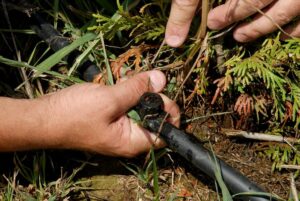There are two main types of garden watering systems. Firstly you’ve got high flow systems, which irrigate heavily for short periods of time (think sprinklers, bubblers and soaker hoses). Secondly there’s low flow systems, which irrigate slowly, but more continuously.
The most common types of low flow irrigation systems are drip systems. These utilise pipes, valves and tubing to deliver water directly to the roots of a plant, either by dripping the water onto the surface, or by burying the system below the soil and delivering the moisture more directly to the roots.
There are many advantages that drip irrigation systems bring to the table, although there are also some notable disadvantages. Let’s take a look at each, and see whether or not a drip system will be the perfect watering solution for your garden.
The Pros
The most notable pro of a drip irrigation system is its ability to save water. The result from being so direct with water delivery is there is little to no evaporation. Almost 100% (and in underground systems, a full 100%) of water is soaked up by the soil, ensuring very little wastage. And if you use a soluble fertiliser in the irrigated water, you’ll also be saving on fertiliser as well!
Because the system is placed either on or just below the surface of the soil, no excavation is required. This means installation is simple, quick, and doesn’t disrupt your garden. If the system is a minor one, you’ll more than likely be able to install it yourself! This also means that if you’re not entirely happy with how your system is positioned, it can be moved incredibly easily.
Drip irrigation cancels out wind drift entirely. Wind drift – the effect that wind can have on high flow systems such as sprinklers – can be an incredibly wasteful. The water that was meant to be delivered to your garden can end up in areas that simply don’t need it (and get dirtied by it), such as driveways, footpaths and the windows of your house.
Because water delivery is kept to specific plants, drip systems can minimise the water available to weeds that may spring up in and around your garden. The direct delivery will also result in maximum growth (and, for fruits and vegetables, maximum yield) for your plants.
High flow systems also have a tendency to erode the soil, with a heavy stream of water kicking up the dirt, and often washing it away. Drip systems cause far less of a disturbance, and ensure that your fertile soil stays where it’s most needed.
The Cons
Because drip systems are designed to emit such a miniscule amount of water, many of their outlets and openings are similarly miniscule. This makes drip systems somewhat prone to clogging. If you have access to potable water for your garden, this will minimise the chances of clogs forming (due to less particles being in the water), but even then, flushing out the system every few months is recommended.
Drip irrigation is simply not viable for lawns and other sprawling garden areas, as it won’t disperse water in a way that such plants demand. While drip watering is perfect for the garden bed or veggie patch, you’ll need to stick to a standard high flow irrigation system for your turf. The same goes for any area of your garden that requires an even dispersion of water over a large area.
As with any artificial irrigation efforts, you need to be careful that your drip watering system doesn’t lead to issues with salinity, as water high in dissolved salts gets delivered straight to your garden bed.
When all’s said and done, a drip system is the obvious solution to the question of watering your garden bed. You’ll save money on water and fertiliser, and can be comfortable with the fact that you’re not being at all wasteful in your gardening efforts.



